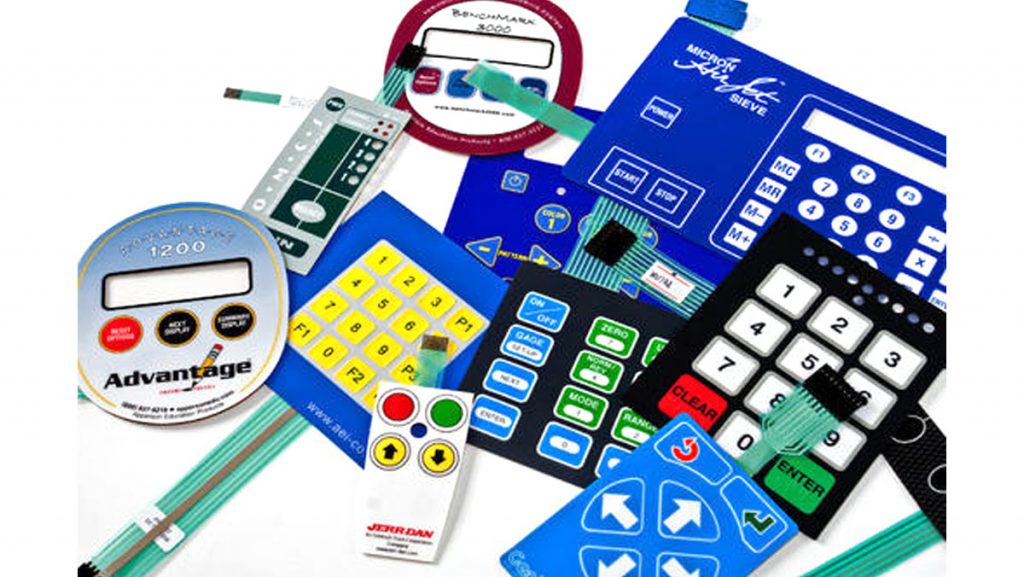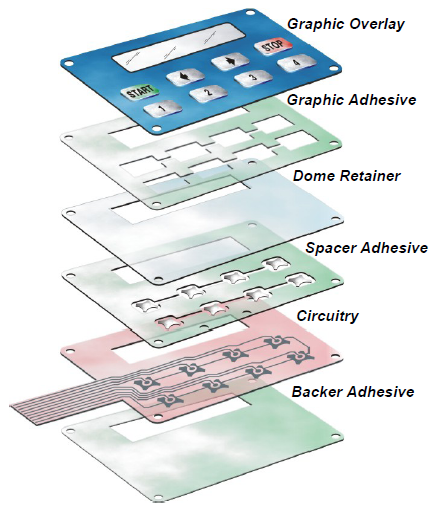Innovations in Membrane Switches for Touch-Sensitive Devices
Understanding the Importance of Membrane Switches in Interface
Membrane buttons are important elements in the design of efficient interface, promoting not only performance but additionally enhancing visual appeal and customer interaction. Their one-of-a-kind functions, such as resistance to ecological aspects and customizable layouts, make them suitable for a diverse selection of applications across numerous markets. As we check out the various advantages and future fads associated with Membrane modern technology, it ends up being clear that these buttons are more than just parts; they represent a convergence of technology and practicality. The ramifications of this technology on individual experience are worth checking out further.
What Are Membrane Switches?

The spacer layer, which contains glue properties, enables the separation of the circuit layer from the overlay, guaranteeing that the switch continues to be in a non-activated state till pressed. When stress is put on the overlay, it compresses the spacer layer, connecting the gap and finishing the circuit in the underlying layer. This layout not only decreases the physical space needed for typical mechanical switches but also boosts the longevity of the gadget, as Membrane buttons are generally immune to dirt, dampness, and other ecological aspects.
Typically found in applications ranging from customer electronic devices to medical tools, Membrane switches are indispensable to contemporary technology, giving a effective and user-friendly user interface that aligns with modern design needs.
Advantages of Membrane Switches
While numerous button technologies exist, Membrane Switches offer distinctive advantages that make them especially desirable in different applications. Among the main benefits of Membrane switches is their portable design, which enables space-saving implementations in gadgets where actual estate is limited. Their thin profile not just enhances aesthetic allure but likewise promotes lightweight building.
Another considerable benefit is their resistance to environmental elements. Membrane buttons are generally secured against moisture, dust, and impurities, making them optimal for usage sought after atmospheres, such as clinical tools and industrial devices. This durability prolongs the life expectancy of the button, decreasing upkeep expenses and boosting integrity.
In addition, Membrane switches can be customized to meet particular style requirements, integrating special graphics and shades that boost customer communication. Their responsive responses alternatives can additionally be customized to provide an enjoyable individual experience. Furthermore, Membrane switches are affordable, especially in high-volume applications, as they can be produced efficiently.
Applications in Different Industries

In the consumer electronics sector, Membrane buttons prevail in gadgets such as microwaves, cleaning makers, and push-button controls. Their responsive comments and aesthetic choices enhance individual experience while providing a streamlined, contemporary appearance. Furthermore, automotive producers use Membrane switches in control panel controls and infotainment systems, where room is restricted, and individual engagement is essential.
Furthermore, the industrial field leverages Membrane buttons in control panels for machinery and devices, enabling user-friendly procedure in typically company website harsh atmospheres. Their resistance to chemicals and dampness guarantees long life and dependability in these applications. In general, the link versatility of Membrane Switches contributes significantly to their extensive usage, making them important in numerous technological domains.
Layout Considerations for Membrane Switches

When designing Membrane buttons, several essential considerations have to be considered to guarantee ideal capability and customer experience. The choice of products is vital; picking sturdy, high-grade substratums can boost the button's durability and resistance to environmental elements such as moisture and temperature fluctuations.
Second of all, the layout of the visuals overlay need to focus on quality and convenience of usage. Icons and message need to be clear, and the design needs to help with user-friendly interaction (membrane switches). Additionally, responsive comments is necessary; integrating a tactile dome or other devices can improve the user experience by providing physical confirmation of activation
An additional essential aspect is the button's electrical efficiency. Designers must ensure that the conductive traces are effectively developed to lessen resistance and prevent signal disturbance. This includes evaluating the called for actuation pressure and guaranteeing compatibility with the digital elements they will certainly user interface with.

Future Trends in Membrane Technology
As innovation remains to development, Membrane switches are positioned to develop dramatically, driven by technologies in materials and making techniques. One emerging trend is the unification of advanced products, such as conductive inks and flexible substrates, which improve resilience and minimize the total weight of Membrane switches. These products not just improve the responsive reaction however likewise enable the design of switches that can stand up to harsher ecological conditions.
Additionally, the assimilation of touch-sensitive modern technologies is transforming conventional Membrane Switches into even more interactive interface. Capacitive touch sensing units embedded within Membrane switch panels can supply an extra receptive and intuitive individual experience, straightening with the expanding demand for smooth, modern-day layouts in customer electronic devices.
Additionally, advancements in printing techniques, such as digital and 3D printing, allow fast prototyping helpful hints and personalization of Membrane buttons. This versatility enables makers to respond faster to market demands and consumer preferences.
Lastly, sustainability is ending up being a substantial focus, with suppliers exploring environment-friendly materials and processes. As these patterns unfold, the future of Membrane modern technology assures boosted performance, visual charm, and environmental responsibility, solidifying their duty in innovative customer interfaces across various industries.
Verdict
In final thought, Membrane Switches represent a crucial element in the layout of individual interfaces, incorporating performance with visual flexibility. As innovations in innovation proceed, the evolution of Membrane buttons is expected to additional improve individual interfaces, driving innovation and boosting usability in a progressively intricate technological landscape.
Membrane buttons are integral elements in the design of reliable user interfaces, assisting in not just functionality however additionally improving visual charm and individual communication.Membrane Switches offer as an essential component in different individual interfaces, promoting a seamless interaction between individuals and digital tools.While various button modern technologies exist, Membrane Switches offer distinct advantages that make them especially preferable in different applications.In addition, Membrane buttons can be customized to meet particular style demands, integrating special graphics and shades that boost customer communication.In verdict, Membrane Switches stand for a crucial part in the layout of customer interfaces, incorporating capability with visual versatility.